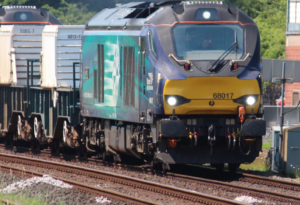Following some questions from members of the public around GDF and transport – we asked the GDF developer to provide a short Q&A:
What is the GDF developer’s plan for transporting nuclear waste from Sellafield to the Search Areas currently taking part in the process?

Image courtesy of Nuclear Transport Solutions (NTS)
In support of site evaluation, Nuclear Waste Services (NWS) will identify an appropriate transport strategy, working with Nuclear Transport Solutions (NTS), for the transportation of radioactive waste from Sellafield in a safe and secure manner.
NWS will seek to work with each relevant Community Partnership to ensure they are appropriately informed with regards to the development of a transport strategy for its Search Area.
NWS studies over the next 12 months will consider feasibility aspects of the transport strategy.
Sellafield will be a key stakeholder wherever the GDF is sited as it currently hosts the majority of the radioactive waste to be disposed of in a GDF. As such, NWS, NTS and Sellafield would need to ensure stakeholders are appropriately engaged.
Would the Cumbrian Coast Line need a rail upgrade if a GDF was built in Copeland?
The Cumbrian Coast Line is a vital piece of infrastructure for the GDF project, as well as for the wider NDA estate. Whether the GDF is sited in Copeland or elsewhere, the rail line will play a key role for the GDF, either in the export of radioactive waste from Sellafield and/or in supporting construction of the GDF and the import of radioactive wastes located elsewhere in the country.
NWS knows capacity is a potential issue on the Cumbrian Coast Line and is working with Nuclear Transport Solutions and Network Rail on a government-sponsored Outline Business Case to look at rail improvements as an enabler for major projects in the area. We will continue to work with Network Rail and Nuclear Transport Solutions to support efforts to safeguard the future of the line.
If the GDF was constructed within Copeland, it’s estimated there would be approximately 5 trains per day to support construction activities.
Once constructed, NWS currently estimates that the export of waste from Sellafield would amount to a maximum of five trains of radioactive waste being consigned per week.
If a GDF was built outside of Mid Copeland, what would the requirement be?
If constructed elsewhere, NWS currently estimates that the export of waste from Sellafield would amount to a maximum of five trains of radioactive waste being consigned per week.
If more nuclear waste needs transported by rail from Sellafield, would this have any effect on passenger services?
Any potential rail movements required for a GDF (including radioactive waste, construction or personnel) would likely be allocated different timetable slots to the existing passenger services. There is the potential for capacity to be improved and this is currently being considered by Network Rail on a government-sponsored Outline Business Case.
It is highly unlikely that the existing passenger rail provisions would be adversely impacted by rail movements for a GDF. If rail infrastructure improvements are required for a GDF, this may even benefit the existing passenger services.
